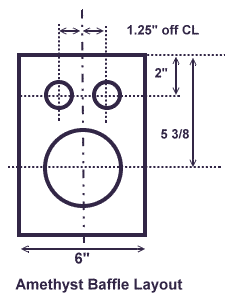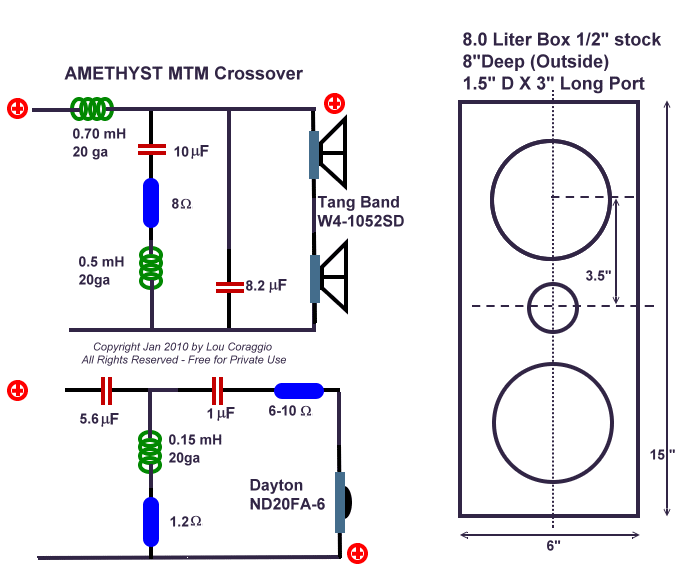Amethyst Micro Monitor -
Clean Tunes for the Stylin' Dorm Dweller
( or for your: bedroom, HT satellite, surround, RV...)
Tang Band W4-1052SD 4" Neo Woofer & Dayton ND20FA-6 Dome Tweeter in 4 Liters
Last Update: Sept 30, 2007 Back to Lou's Homepage
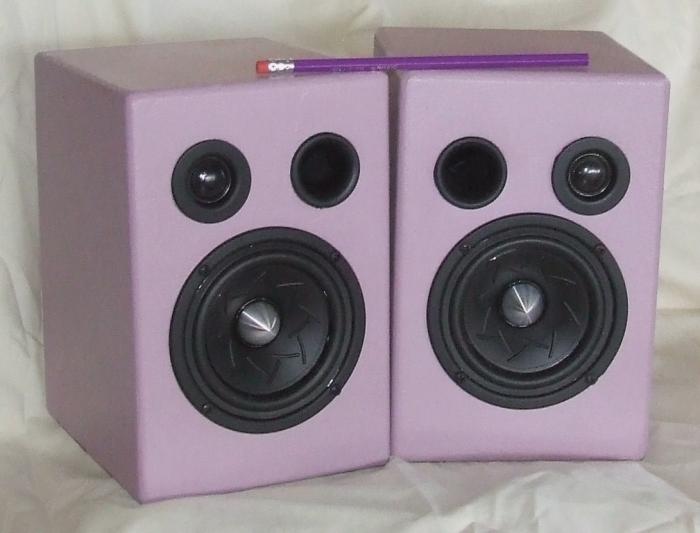
A sure sign of advancing age is the shock of realizing that cute little girl you've known for years is now off to college. [But she was just a kid last time I looked..]. When one of my oldest friends told me his daughter had chosen to move into a dorm at an Incredibly MAssive Desert Institute of Parties (IMADIP), I knew she needed a proper sound system. Not a "death by decibel" setup, but something durable, compact, and accurate enough to see how bad those compressed MP3's really sound. [Yes Buffie, there are serious students in your party school...]
I thought the Nugget 2 would be a great start. But the rear ports of the Nugget2 wouldn't work well when buried on a shelf or a desktop, maybe hung on a wall. Christina is fairly discriminating young woman who's especially fond of all shades of pink & purple. The speakers had to "coordinate" with her dominantly purple decor. I couldn't envision those brown cones against a purple speaker. [What would Martha say!] So I decided a new design was needed.
I already had a Sonic Impact T-AMP in mind. So I looked for an efficient driver, capable of decent bottom end in a small box. Not an easy task. After looking over the selections, I chose the Tang Band W4-1052SD 4" Driver. It looked cool, fairly durable, and reasonably efficient. I don't know that it will handle a full beer immersion, but it might make 4 years with proper care. I matched it up with Dayton ND20FA-6. I figured it gave me good flexibility and could be easily replaced if poked out by an errant pen. Both drivers are surface mounted.
For the finish, I started with a cup or so of the gray Duratex that I used on the Cyclops. I added a variety of water-soluble pigments & dyes from my wood staining kit. Adding a few drops of reds & violet a little bit at a time and I was able to come up with a pleasing pastel. [My wife and daughter both appoved! Thought they were "cute"] I applied three coats with a cheap little foam roller to give it some texture. Adding the pigments didn't seem to affect the finish quality at all.
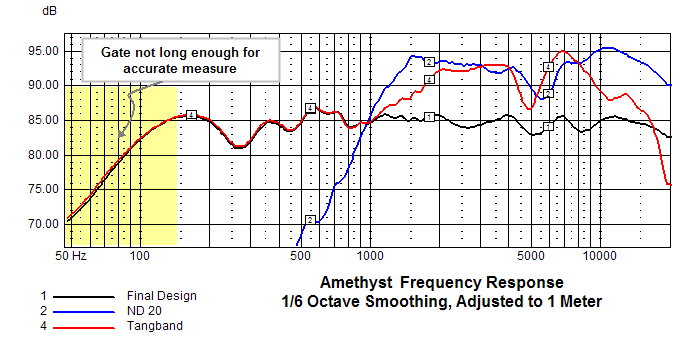
Box and Crossover Parts List
I built these as a mirrored pair with the port & tweeter merely swapping places. The flared port I used [PE 260-470] needs a 1 3/8" hole while the ND-20 requires 1 5/16". Close but not interchangeable. There's no additional bracing in the box, 3 sides are lined with accoustic foam. The box is lightly stuffed with Dacron. I used tiny beads of PE sealing caulk around the tweeter and port, closed cell foam tape around the woofer.
I thought the visual symmetry worked out. I tried to locate the tweeter at unequal distances to the edges in an effort to spread out the edge diffraction. As you can see from the curves below, there's still a significant tweeter dip at 6000. The Tang band could be construed as a "full range" driver. But the edge diffraction combined with cone break up to make a ragged trough & peak between 5000 & 7000. I probably could have mitigated this by moving the woofer down on the baffle. As it turned out there was enough "headroom" to work out the issues with the crossover.
I tried a variety of simple 2nd order crossovers but nothing really sounded right. The two best candidates both had notch filters (one series, the other parallel). I built both, but finally settled on the version you see here. The crossover is a bit above 5000 Hz -- right in the middle of all that wild response. Looking at individual drivers, both slopes effectively are 4th order LR in shape. But the tweeter rolls at 5000, the woofer at about 6000. The overlap helped smooth things out in the notchy area. The notch filter also allowed for some shaping of the curves in the 2000 Hz area.
I tried running the Tangband full range, but I found the top end a bit too gritty for my taste. Lower crossover points just brought out that grit (cone breakup?). By twiddling with the two cap values and the two padding resistors, I was able to keep the driver phase pretty consistent at a variety of distances and maintain a reasonably benign impedance profile. I couldn't completely smooth out all the "busyness" but I did reduce it to virtual inaudibility. While the component count is a bit high, with electrolytic caps, I still think it's a reasonably priced box.
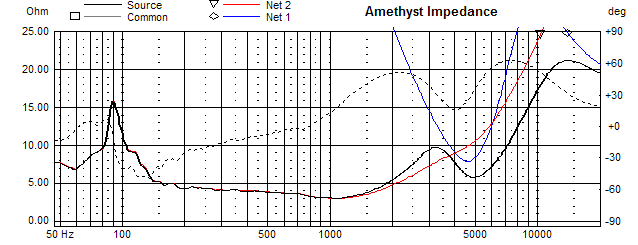
Listening Impressions
Reflecting back on the early days of huge, beamy boxes (like my ex- roommate's La Scala's) I'm amazed by the size and coherence of soundstage presented by small boxes in general, and these little gems in particular. They had no problem filling my sizeable kitchen/dining room (15' X 25') with a very stable soundstage. I ran them off the countertop, in a bookshelf, on my desktop. Overall, very smooth and silky with serious bass slam (for a 4" driver). Nicely balanced in a variety of locations. There's some obvious off axis beaming from the Tangband, but these are really capable "full range" speakers at reasonable listening levels.
Curves sugggest 96 dB from the 15 watt SonicImpact T amp. I'm not sure I'd feed them a full range signal at much more than 15-20 watts anyway. Despite the 4 ohm impedance, my Panasonic XR50 had no problem driving these to fairly high levels, so the impedance profile should be fairly benign.
The Tangband reproduces the vast majority of the musical spectrum. The tweeter handles mostly harmonics. Soooo... there's no hand off in the critical range for vocals and lead instruments. As long as the driver handles this area well, there's no sibilance issues or other mission critical distortion or phasing. This little Tangband is definitely up to the task. I agree with Dr. K, undersizing the box on small drivers typically enhances the quality of bass. [I suspect the smaller box and higher tuning will better control driver movement.] No 4" driver is going to shake the walls AND handle a piccolo perfectly, but this one does a commendable job on both. This is a very capable, versatile box [with high SAF] that could serve you in a variety of in home and mobile uses.
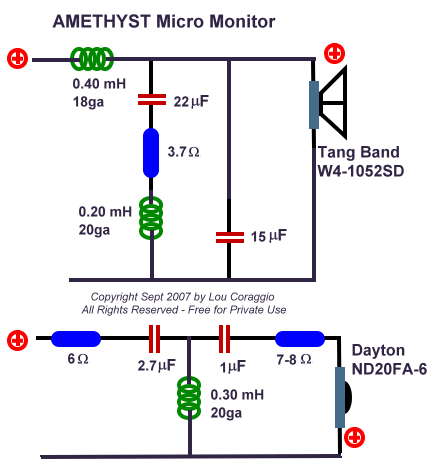
- 4.0 Liters, 250 Cu. In.
- 1/2 inch stock
- 9" H x 6" W x 7.25" D
(Outside Dimensions) - 1 in. Diameter by 3 in. Port
- Tuning & F3 about 62 Hz
